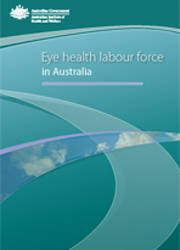Summary
Eye health labour force in Australia is the fourth in a series of national reports providing an overview of eye health and eye health care in Australia. This report contains national information on the characteristics of the eye health labour force from a range of data sources.
The eye health labour force consists of the health professionals: ophthalmologists, ophthalmic nurses, optometrists and orthoptists; and tradespersons such as optical dispensers and optical mechanics.
Key findings
- The prevalence of eye problems increases with age. As a result of population ageing, the demand for eye health workers is likely to increase in the future.
- According to the AIHW health labour force surveys the Australian eye health labour force includes 735 full-time equivalent (FTE) ophthalmologists (2006 estimate) and 421 FTE ophthalmic nurses (2004 estimate).
- Based on the 2006 ABS Census of Population and Housing there were also:
- 3,329 FTE optometrists
- 471 FTE orthoptists
- 3,177 FTE optical dispensers
- 1,081 FTE optical mechanics.
- For those occupations where time series data are available, there has been evidence of growth. The number of FTE ophthalmologists and optometrists increased by 15% and 11% respectively between 2001 and 2006. The number of FTE orthoptists increased by 20%.
- There has been a slight increase, both in the number of trainee ophthalmologists and course completions in ophthalmology, as a proportion of employed ophthalmologists between 2001 and 2006. The same is true of optometrists.
- Ophthalmologists are on average older than other eye health workers. In 2006 the average age of ophthalmologists was 52 years. The average age of the other eye health occupations ranged from 36 years (orthoptists) to 46 years (ophthalmic nurses).
- The data suggest a trend towards feminisation of the eye health workforce. The proportion of female ophthalmologists, optometrists and orthoptists increased by between 3 and 4 percentage points between 2001 and 2006. Ophthalmic nurses and orthoptists had the highest proportion of females amongst eye health workers (96.3% and 90.1% respectively). Ophthalmologists had the lowest proportion of female workers (15.7%).
- The majority of eye health workers work in Major cities. In 2006 about 80% of eye health workers lived in Major cities, while less than 70% of the Australian population and 67% of Australians with eye disorders lived in Major cities (ABS 2006a).



